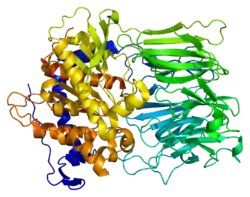Prolylendopeptidase
Prolylendopeptidase (Prolyl-endo-Peptidase, PEP), auch Prolyloligopeptidase (Prolyl-Oligopeptidase, POP) genannt, ist ein Enzym, das als Endopeptidase eine spezifische Peptidbindung innerhalb eines kurzen Polypeptids trennt und es so spaltet.
| Prolylendopeptidase | ||
|---|---|---|
 | ||
|
Vorhandene Strukturdaten: 3DDU | ||
| Eigenschaften des menschlichen Proteins | ||
| Masse/Länge Primärstruktur | 80.751 Dalton / 710 AS | |
| Bezeichner | ||
| Gen-Name | PREP | |
| Externe IDs |
| |
| Enzymklassifikation | ||
| EC, Kategorie | 3.4.21.26, Serinprotease | |
| MEROPS | S09.001 | |
| Reaktionsart | Hydrolyse einer trans-Pro-Xaa-Peptidbindung | |
| Substrat | Oligopeptid | |
| Produkte | Oligopeptid | |
| Vorkommen | ||
| Homologie-Familie | Hovergen | |
| Übergeordnetes Taxon | Lebewesen[1] | |
| Orthologe | ||
| Mensch | Hausmaus | |
| Entrez | 5550 | 19072 |
| Ensembl | ENSG00000085377 | ENSMUSG00000019849 |
| UniProt | P48147 | Q9QUR6 |
| Refseq (mRNA) | NM_002726 | NM_011156 |
| Refseq (Protein) | NP_002717 | NP_035286 |
| Genlocus | Chr 6: 105.28 – 105.4 Mb | Chr 10: 45.07 – 45.16 Mb |
| PubMed-Suche | 5550 | 19072 |
Prolylendopetidasen spielen im Menschen bei der Produktion und dem Abbau von Peptidhormonen und Neuropeptiden eine Rolle. Es handelt sich dabei um Serinproteasen, wie sie in allen Lebewesen zu finden sind. Inhibitoren der PEP können die Konzentration mehrerer Neuropeptide im Gehirn erhöhen; bei Ratten als Versuchstieren war dies mit einer gesteigerten Gedächtnisleistung verbunden. PEPs sind daher ein interessantes Target für die Pharmaindustrie.[2][3][4]
Genetik und Aufbau
Das für die Prolylendopeptidase codierende PREP-Gen befindet sich beim Menschen auf Chromosom 6 Genlocus q22.[5] Es besteht aus 2562 Basenpaaren.[6] Im menschlichen Genom wurden keine homologen Gene identifiziert.[7]
Das Genprodukt besteht beim Menschen aus 710 Aminosäuren und hat eine molare Masse von 80.751 Dalton.[8]
Funktion


Prolylendopeptidase ist eine Prolin-spezifische Protease. Sie spaltet Peptide bis zu einer Größe von meist maximal 10 kDa (≈30 Aminosäuren) am C-Terminus von Prolin (daher auch der Name).[9][10][11][12][13] Man spricht auch von einer post-Prolin-spaltenden Endopeptidase.[7] Dazu muss das Prolin in trans-Konfiguration vorliegen. Prinzipiell können auch längere prolinhaltige Peptide gespalten werden, wenn diese eine leicht aufzufaltende Sekundärstruktur haben und so über den N-Terminus in den zentralen Kanal der Prolylendopeptidase eindringen können. So kann beispielsweise das 40 kDa schwere p40-Phox-Protein mittels Prolylendopeptidase gespalten werden.[7][14]
Auch wenn Struktur, katalytischer Mechanismus und Substratspezifität von PEP weitgehend bekannt sind, so ist das Wissen über die physiologische Funktion dieses Enzyms noch sehr vage. Bei einer Reihe psychischer Störungen und neurodegenerativer Erkrankungen spielt PEP offensichtlich eine Rolle. Bei einigen Krankheitsbildern, wie Bipolaren Störungen und Schizophrenie ist die Aktivität der Prolylendopeptidase erhöht, bei anderen, wie beispielsweise Alzheimer, Parkinson, Lewy-Körper-Demenz und Chorea Huntington erniedrigt. Es wird daher vermutet, dass PEP an neurodegenerativen Prozessen beteiligt ist.[15] Dafür spricht auch, dass durch die Gabe des Antiepileptikums Valproinsäure oder des Antidepressivums Fluoxetin (Prozac), die Aktivität von PEP im Serum auf normale Werte gesenkt werden kann.[16] Mittlerweile ist eine Reihe von spezifischen Inhibitoren für Prolylendopeptidase bekannt. Beispielsweise das Alkaloid Berberin[17] oder das Flavonoid Baicalin[18]. PEP-Inhibitoren sind im Tiermodell Maus in der Lage induzierte Gedächtnisstörungen teilweise oder gar vollständig zu beheben.[19][20] Einige dieser Verbindungen sind als potenzielle Nootropika oder Antidepressiva in der klinischen Erprobung. Die genauen molekularen Mechanismen über den Einfluss von PEP sind jedoch noch weitgehend unklar.[7]
Vorkommen
Das Enzym wurde 1971 erstmals aus der Gebärmutter einer Frau isoliert.[21] PEP findet sich in allen Säugetieren,[22] beispielsweise in den Muskeln, Nieren, Lungen oder dem Gehirn.[23][24] In malignen Tumoren wird PEP überexprimiert.[24] Im gesunden Gehirn, und dort speziell in der Großhirnrinde und im Neostriatum, ist die Aktivität besonders hoch.[23][25][26] Weitgehend unklar ist indes, in welchen Zellkompartimenten sich das Enzym befindet. Es wurde im Zytosol,[27] im Zellkern,[28] synaptosomal[29] und extrazellulär[30] nachgewiesen, allerdings spricht die Proteinsequenz eher für ein rein intrazelluläres Vorkommen.[7]
Produkte
Es werden in Deutschland Nahrungsergänzungsmittel für Gluten-/Weizensensibilität mit diesem Enzym in den Verkehr gebracht, zum Beispiel das Präparat „Gluteostop“.[31]
Weiterführende Literatur
- P. Morain u. a.: S 17092: a prolyl endopeptidase inhibitor as a potential therapeutic drug for memory impairment. Preclinical and clinical studies. In: CNS Drug Rev 8, 2002, S. 31–52. PMID 12070525 (Review)
- K. Toide u. a.: A novel prolyl endopeptidase inhibitor, JTP-4819 – its behavioral and neurochemical properties for the treatment of Alzheimer's disease. In: Rev Neurosci 9, 1998, S. 17–29. PMID 9683325 (Review)
- K. Kimura u. a.: Prolyl endopeptidase inhibitors derived from actinomycetes. In: Bioscience, Biotechnology, and Biochemistry 61, 1997, S. 1754–1756. PMID 9362123 (Review)
- K. Nomura: Specificity of prolyl endopeptidase. In: FEBS Lett 209, 1986, S. 235–237. PMID 3539636
Einzelnachweise
- Homologe bei OMA
- Kamei H, Ueki T, Obi Y, Fukagawa Y, Oki T: Protective effect of eurystatins A and B, new prolyl endopeptidase inhibitors, on scopolamine-induced amnesia in rats. In: Jpn J Pharmacol. 60. Jahrgang, Nr. 4, Dezember 1992, S. 377–80, PMID 1287273.
- Li J, Wilk E, Wilk S: Inhibition of prolyl oligopeptidase by Fmoc-aminoacylpyrrolidine-2-nitriles. In: J. Neurochem. 66. Jahrgang, Nr. 5, Mai 1996, S. 2105–12, PMID 8780042.
- Venäläinen JI, Garcia-Horsman JA, Forsberg MM, et al.: Binding kinetics and duration of in vivo action of novel prolyl oligopeptidase inhibitors. In: Biochem. Pharmacol. 71. Jahrgang, Nr. 5, Februar 2006, S. 683–92, doi:10.1016/j.bcp.2005.11.029, PMID 16405869.
- Prolylendopeptidase. In: Online Mendelian Inheritance in Man. (englisch)
- G. van Hoof u. a.: Cloning and sequence analysis of the gene encoding human lymphocyte prolyl endopeptidase. In: Gene 149, 1994, S. 363–366. PMID 7959018
- I. Schulz: Abhängigkeit der Inositol-(1,4,5)-triphosphat-Konzentration von Prolylendopeptidase – Ein neuer molekularer Mechanismus zur Erklärung des Einflusses von Prolylendopeptidase-Inhibitoren auf seelische und neurodegenerative Erkrankungen. Dissertation, Martin-Luther-Universität Halle-Wittenberg, 2003.
- D. Rennex u. a.: cDNA cloning of porcine brain prolyl endopeptidase and identification of the active-site seryl residue. In: Biochemistry 30, 1991, S. 2195–2203. PMID 1900195
- A. C. Camargo u. a.: Involvement of endo-oligopeptidases A and B in the degradation of neurotensin by rabbit brain. In: J Neurochem 42, 1984, S. 1758–1761. PMID 6327912
- W. L. Taylor u. a.: New fluorogenic substrates for a rat brain proline endopeptidase. In: Anal Biochem 105, 1980, S. 58–64. PMID 7004269
- A. Moriyama u. a.: Porcine muscle prolyl endopeptidase and its endogenous substrates. In: J Biochem 104, 1988, S. 112–117. PMID 2851585
- G. van Hoof u. a.: Proline motifs in peptides and their biological processing. In: FASEB J 9, 1995, S. 736–744. PMID 7601338
- D. F. Cunningham und B. O'Connor: Proline specific peptidases. In: Biochim Biophys Acta 1343, 1997, S. 160–186. PMID 9434107
- T. Hasebe u. a.: Involvement of cytosolic prolyl endopeptidase in degradation of p40-phox splice variant protein in myeloid cells. (Memento des vom 2. Juni 2008 im Internet Archive) Info: Der Archivlink wurde automatisch eingesetzt und noch nicht geprüft. Bitte prüfe Original- und Archivlink gemäß Anleitung und entferne dann diesen Hinweis. In: J Leukoc Biol 69, 2001, S. 963–968. PMID 11404383
- D. Mantle u. a.: Comparison of proline endopeptidase activity in brain tissue from normal cases and cases with Alzheimer's disease, Lewy body dementia, Parkinson's disease and Huntington's disease. In: Clin Chim Acta 249, 1996, S. 129–139. PMID 8737597
- M. Maes u. a.: Alterations in plasma prolyl endopeptidase activity in depression, mania, and schizophrenia: effects of antidepressants, mood stabilizers, and antipsychotic drugs. In: Psychiatry Res 58, 1995, S. 217–225. PMID 8570777
- T. Tarrago u. a.: The natural product berberine is a human prolyl oligopeptidase inhibitor. In: ChemMedChem 2, 2007, S. 354–359. PMID 17295371
- T. Tarragó: Baicalin, a prodrug able to reach the CNS, is a prolyl oligopeptidase inhibitor. In: Bioorganic & Medicinal Chemistry 16, 2008, S. 7516v7524. PMID 18650094
- M. Nanri und H. Kaneto: Anti-amnesic effect of prolyl endopeptidase inhibitors in mice. In: Nippon Yakurigaku Zasshi 89, 1987, S. 323–329. PMID 3305244
- T. Yoshimoto u. a.: Specific inhibitors for prolyl endopeptidase and their anti-amnesic effect. In: J Pharmacobiodyn 10, 1987, S. 730–735. PMID 3330562
- R. Walter u. a.: Leucylglycinamide released from oxytocin by human uterine enzyme. In: Science 173, 1971, S. 827–829. PMID 5572174
- T. Kato u. a.: Distribution of post-proline cleaving enzyme in human brain and the peripheral tissues. In: Mol Cell Biochem 32, 1980, S. 117–121. PMID 7007867
- J. Irazusta u. a.: Distribution of prolyl endopeptidase activities in rat and human brain. In: Neurochem Int 40, 2002, S. 337–345. PMID 11792464
- F. M. Goossens u. a.: Distribution of prolyl oligopeptidase in human peripheral tissues and body fluids. In: Eur J Clin Chem Clin Biochem 34, 1996, S. 17–22. PMID 8704029
- R. Mentlein: u. a.: Proline-specific proteases in cultivated neuronal and glial cells. In: Brain Res 527, 1990, S. 159–162. PMID 2282478
- M. E. Gallegos u. a.: The activities of six exo-and endopeptidases in the substantia nigra, neostriatum, and cortex of the rat brain. In: Neurochem Res 24, 1999, S. 1557–1561. PMID 10591406
- K. Dresdner u. a.: Subcellular distribution of prolyl endopeptidase and cation-sensitive neutral endopeptidase in rabbit brain. In: J Neurochem 38, 1982, S. 1151–1154. PMID 7038048
- T. Ishino u. a.: cDNA cloning of mouse prolyl endopeptidase and its involvement in DNA synthesis by Swiss 3T3 cells. In: J Biochem 123, 1998, S. 540–545. PMID 9538240
- R. M. O’Leary und B. O'Connor: Identification and localisation of a synaptosomal membrane prolyl endopeptidase from bovine brain. In: Eur J Biochem 227, 1995, S. 277–283. PMID 7851396.
- F. Goossens u. a.: A sensitive method for the assay of serum prolyl endopeptidase. In: Eur J Clin Chem Clin Biochem 30, 1992, S. 235–238. PMID 1525255
- Marc Schneider: Fachinformation Gluteostop. (PDF) ineo Pharma GmbH, abgerufen am 22. April 2020.
Weblinks
- prolyl endopeptidase (Homo sapiens). Entrez Protein (englisch)
- Prolyl oligopeptidase with gsk552. EMBL-EBI (englisch)